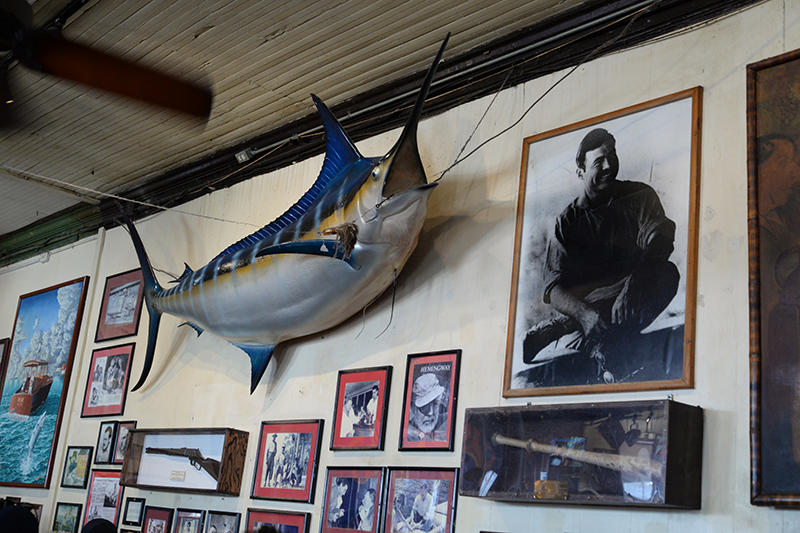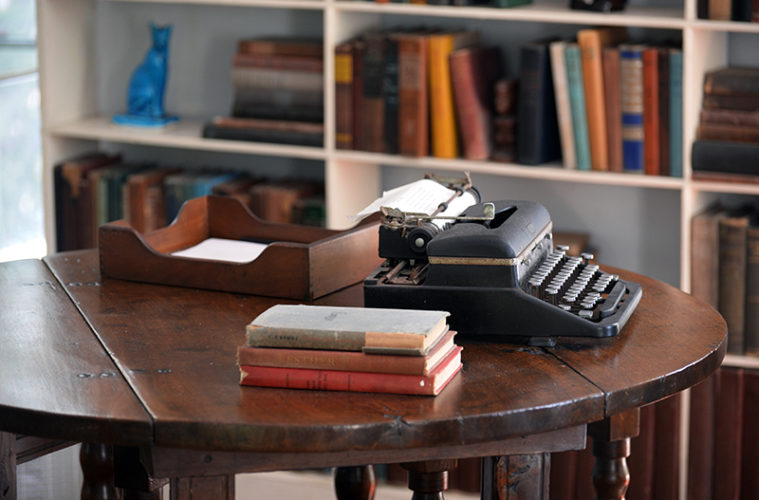The famed “The Old Man and the Sea” novelist leaves a lasting impression on the seaside Florida town of Key West
If Paris is a “moveable feast” as Ernest Hemingway touted, then Key West is the dolce. And for those who come here, they find the picturesque atmosphere, offbeat charm, and funky rhythms a welcoming dessert. Today, Key West thrives in part because the iconic writer prospered here, and he left imprints of a legacy still visible today.
There’s no better way to understand the biography of an author than to experience the place where he or she lived and wrote. Hemingway first arrived here in 1930 filled with hopes of anonymity and the promise of tropical warmth. His Paris years were behind him; the city that he once cherished was overcrowding, and its winters were long and gloomy. The already famous author and his second wife Pauline had not lived under one roof more than a month or two since their marriage in 1927.
When he purchased the Spanish Colonial style house at 907 Whitehead Street in 1931, it had fallen into bewildering disrepair. A massive restoration and remodeling made it habitable. Conspicuous in Old Town, the house that you see today has aged remarkably well in a tropical climate and, fortunately, was spared the ravages of Hurricane Irma in 2017.
Certainly Hemingway must have been awakened at first light each morning by the rooster crows as visitors are now. No alarm clocks are needed. The dazzlingly feathered chanticleers, along with the “Gypsy Chickens,” roam the streets and yards willy-nilly, unfazed by the teeming bustle around them. Two versions account for their origins. In the first, migrants who came here brought along their flocks as a reliable food source to this isolated peninsula. The second claims the unique breed, “Cubalaya,” accompanied Cuban immigrants for the purpose of entertainment in cockfights. In the 1970s, the practice was outlawed, and the roosters are allowed to roam free.
The Hemingway house appears almost as wholly as when the Hemingways lived here for nine years, though “lived” is a bit of a stretch since he was away for extended stays in Spain or Cuba. The rooms faithfully reflect the personal tastes of the Hemingways; much of the furniture is authentic, gathered from places where he stayed in Europe. Many are antiques. Since the house has been a museum since 1964, the rooms have been modified with display cases and wall hangings to showcase aspects of his life.
Though Hemingway cultivated a macho persona, his gentle side liked cats. Make that adored cats. At any one time while he resided here, over twenty called this place home. About 50 or so live here today. And all are polydactyl ( six-toed). Nonchalantly they roam the grounds doing what cats do anywhere– linger, climb, and sleep. They are thought to be descendents of Maine Coon cats, a large breed from the Eastern United States seaboard, used once in seafaring as defenses to control rodents. Sailors considered them good luck. Hemingway named all of them, often after famous people.
Hemingway taught one of his cats, Friendless, “to drink with me (Whisky[sic] and milk),” he wrote in a 1943 letter.
On the grounds, stop by the Cat Cemetery to examine the gravestones marked with names like Liz Taylor, Frank Sinatra, and Zsa Zsa Gabor, not all his choices, but revealing nonetheless.
For an intimate look at his writer’s space, climb to the second floor of the nearby cottage where his writing studio overlooks lush gardens and the swimming pool. His original Corona typewriter sits on a wooden table as if waiting for the author to show up to write. Here he wrote the best-selling novels, For Whom the Bell Tolls andTo Have and Have Not along with the play,The Fifth Column, and many short stories including “The Snows of Kilimanjaro.” The room is airy, lined with books, and accented with collectables from his world travels and hunting safaris.
Exit to Whitehead Street and go east a few blocks to stand next to the large buoy monument marking the southernmost point in the Continental United States. Wonks will argue that it’s not precisely and geographically accurate (the true latitude and longitude is on a privately owned island south and west). But it’s the farthest point publically accessible and provides a photo op not to be missed.
Of course Hemingway was a legendary hard-drinking adventurer, so a must-see stop-off point is Sloppy Joe’s Bar, his favorite haunt. After a morning of writing, starting at six a.m., where most days he wrote about 300 to 700 words, he moseyed over barefoot, his shorts held up by a rope, to hold court with “The Mob,” a good-time crowd of serious drinkers, some famous like writer John Dos Passos and painters Henry Strater and Waldo Pierce, and some just plain old salts. He once said facetiously, “I used to be co-owner of Sloppy Joe’s, silent partner they call it.”

You can’t sit where Hemingway sat since the bar has moved twice over the years. But you can order a delicious double-daiquiri named after him as a Papa Doble and feast on snacks and light food faire. The vibe is inclusively high-energy, and the stage is rarely empty of a rockin’ band. An array of Hemingway photographs occupy one wall beneath a giant blue marlin suspended in air.
To tap the spirit of another Key West legend, visit the original Jimmy Buffet Margaritaville, originally founded in 1985 as a store to sell clothing and other ephemera espousing his chill-and-let-chill pop philosophy. In two years it expanded to include an adjacent cafe by day and night club after dark with live music.
Though Hemingway was alive when President Harry S. Truman became smitten by Key West’s charms, the writer had remarried and moved to Cuba. For a different step-back into history, The Little White House provides glimpses of Truman’s time here. During his four years as president, he used the house 175 days as a second functioning White House. Additionally, five other presidents used the house as a retreat and to conduct affairs of state. A 45-minute guided tour allows you to experience Truman’s second home.
During the day I spent here on a busy mid-afternoon in May, I landed the last available table at Sloppy Joes. I was sipping Hem’s favorite drink, when the band struck up the Red Sox anthem, “Sweet Caroline,” and I joined the crowd in song. Somehow the refrain summed up Key West’s– and Hemingway’s– enduring fascination: “So good! So good! So good!”

